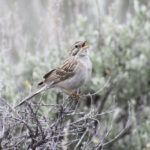By Michael Howell
The Bitterroot Audubon Society and the Five Valley Audubon Society joined up to sponsor a citizen scientist survey of sage lands in the Bitterroot Valley at the end of May. The aim was to train a cadre of citizen scientists to identify various birds commonly associated with

sagebrush habitat and then send them out to various spots in the valley to see what they could find. All the data collected is shared publicly via eBird, an on-line bird data archive sponsored by Cornell University. The eBird site is the largest citizen science project in the world
According to Bitterroot Audubon member Kate Stone, about 10,000 acres of sage land has been mapped in the Bitterroot Valley. Be
sides looking for birds the citizen scientists are also mapping and assessing the quality of the sage habitat. She said much of the sage land on the Forest has been surveyed but habitat located on private land has not gotten the same attention.
“A lot of sage land has been lost over the years as land was developed and cleared for farming and ranching and housing developments,” said Stone, “but there is still a lot left in the valley.”
Audubon members trained the volunteers to identify birds by sight as well as by song. Stone said that the small birds commonly associated with sage habitat are not very colorful and are hard to spot. She said identifying the birds by song aided immensely in conducting the surveys.
About 20 citizen scientists participated in the latest survey, visiting 15 different patches of sage land located from Skalkaho southeast of Hamilton, to Reed Butte, just east of Stevensville. The surveyors counted a total of over 400 birds, identifying 52 different species.
Common sagebrush birds like the Vesper Sparrow, the Chipping Sparrow, the Clay-colored Sparrow and the Brewer’s Sparrow were identified. The most commonly identified bird in the survey was the Vesper Sparrow. Forty-seven Vesper Sparrows were identified. Sixteen Brewer’s Sparrows were identified, tripling the known distribution records for the species in the Bitterroot. No Sage Thrashers were identified despite the fact that they are one of the most common sagebrush species.
Stone has produced a field identification guide for some of the sagebrush birds with photographs taken in the Bitterroot which the citizen scientists took into the field with them. Stone said that most of the surveys conducted this past month were done from the roadside, but anyone with sagebrush on their property that would like to have the sage land surveyed can contact her to make arrangements by calli
ng her at 381-1115 or e-mailing krosestone@hotmail.com.
For more information about sagebrush birds go to Birds in a Sagebrush Sea at http://www.partnersinflight.org/wwg/sagebrush.pdf.